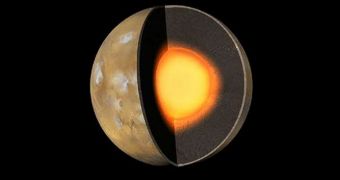The NASA rover Spirit has been recently transformed into a stationary science platform. Experts from the Jet Propulsion Laboratory (JPL), in Pasadena, have over the past months attempted all they could to release the robot, but failed. The machine's predicament is simply too great, and there is currently no way for it to be taken out of the sandy trap that has been keeping it prisoner for nearly a year. However, if mission controllers play their cards right, they may be able to conduct a host of new experiments that were not possible before, Space Fellowship reports.
By tracking the radio signals the rover emits throughout the Martian winter, researchers back on Earth could gain a wealth of new knowledge on the Red Planet's core, as well as of its wobble through space. Knowing these data could make it easier for astronomers to calculate a host of properties that the inner parts of the planet has, which cannot be analyzed with existing equipment on or around Mars. “In this case, it’s a good thing Spirit is immobile. We can track its radio signal to determine its motion through space,” says Cornell University expert Steve Squyres, who is the principal investigator of the MER mission. He adds that Spirit's immobility allows for experts to determine the location of its radio antenna at all times, thus gaining new knowledge on how Mars spins around its own axis.
“Mars wobbles, or precesses, as it spins. We’ll measure that wobble by looking at the Doppler shift of Spirit’s radio signal. Mars completes an entire wobble only once every 170,000 years. So we’ll be measuring a very tiny motion – looking at minute changes. But these minuscule numbers speak volumes about Mars’ core,” explains JPL expert Bruce Banerdt. “If Mars’ core is solid through and through, the nature of the wobble will be subtly different from the wobble if the core is liquid,” Squyres says. Geologists and planetary scientists have so far believed that the planet's core might have been liquid in the past, but are unsure whether this is also the case at this point.
They explain that a molten core causes a magnetic field to appear, which may be an asset for future expeditions there. However, no one knows for sure if the core is still fluid, or how much of it has stopped spinning. “This research has implications that reverberate through all kinds of basic questions about the formation of the solar system and its planets. I have to tip my hat to Spirit. It keeps coming up with new tricks,” Banerdt concludes.

 14 DAY TRIAL //
14 DAY TRIAL //